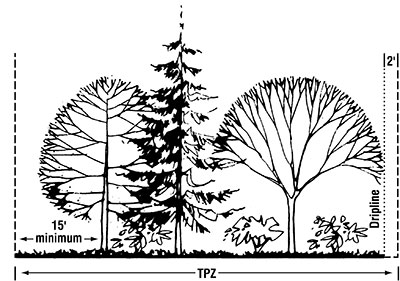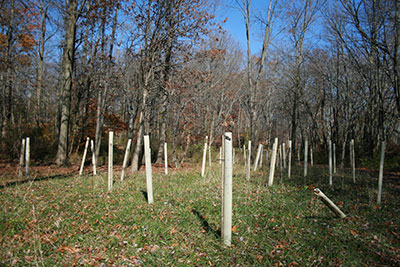Tree Protection and Replacement Ordinance Standards
Municipalities can do a great deal to protect trees and woodlands in their communities through ordinance protection standards. These standards, implemented through the zoning and subdivision and land development ordinances, can both protect existing trees and add new trees as part of the land development process. Some amount of tree removal is often necessary during the development process; however, municipal codes can reduce the ecological impact of woodland and tree removal by limiting disturbance to mature trees and/or healthy woodlands with high ecological value. Municipal codes should prioritize the preservation of existing trees, particularly mature native trees, specimen trees and heritage trees, as replacing these trees' ecological, aesthetic and functional value takes decades.
Woodlands Protection Standards
Municipal tree protection standards should limit the removal and disturbance of existing trees during the land development process. Woodland protection ordinances are typically found in the zoning ordinance as part of a package of natural resource protection standards. Municipal ordinances can impose limits on woodland removal in a number of ways. Some examples include:
- Limiting the disturbance of existing woodlands to a given percentage: A maximum disturbance limit of no more than 50 percent should be considered, and potentially even lower disturbance of 35 percent permitted for residential development.
- Requiring a tree survey be performed as part of an existing conditions plan, and limiting disturbance based on the caliper size of existing trees. This approach may be most appropriate for smaller development projects where conducting a tree survey would not be cost prohibitive.
- Requiring a woodland delineation be performed, and attaching a maximum percentage of each class of woodland that can be disturbed. This approach is appropriate for large development projects, and for municipalities with important and high-value woodland resources on developable land.
Tree Protection Standards During Construction

Tree Protection Zone
Equally important to protecting existing woodlands is to ensure that trees that are to remain on site are protected during construction through establishing tree protection zones. Tree protection ordinance standards are typically found in the subdivision and land development ordinance, although if a municipality wishes to protect trees outside of the land development process, these standards can be placed in the zoning ordinance or cited by a cross-reference from the zoning ordinance. The analysis of existing trees should occur early in the design process, and existing trees to remain should be shown on development plans. To demonstrate adequate protection of existing trees, plans showing existing trees to remain should also show tree and root protection zones, tree protection zone barriers, soil erosion and compaction controls, staging and storage areas, and existing and proposed utilities.
Municipalities may wish to refer to industry standards for tree protection within their ordinance:
- ANSI A300-Part 5, Management of Trees During Development and Construction
- Fite, K., & Smiley, E. T. (2023). Best Management Practices: Managing Trees During Construction-3rd Edition. International Society of Arboriculture.
- Matheny, N. P., & Clark, J. R. (1998). Trees and Development: A Technical Guide to Preservation of Trees During Land Development. International Society of Arboriculture.
Further information and ordinance examples for protecting woodlands, trees, and other natural resources are covered in a series of eTools on the Planning Commission website. The eTools that most specifically address topics related to tree woodland protection include:
These eTools include links to sample ordinance language for woodland and tree protection and replacement.
Tree Replacement Standards
In addition to protecting existing trees, municipalities can work towards a net-zero loss of trees by requiring the replacement of trees that have been unavoidably removed during the development process. The following examples of tree replacement ordinance standards have been adopted by municipalities in Chester County. As noted under Planting and Maintaining New Trees, the use of native tree species is highly recommended and can be included as a requirement in ordinances.
These examples are located in the subdivision and land development ordinance which provides some flexibility in how the standards are applied. While this flexibility can be useful where the replacement standards are difficult to fully implement due to site conditions, municipalities are highly encouraged not to waive the standards as a general practice. Please note that this list is not all inclusive and municipalities handle tree replacement in several different ways. Based on our inventory, at least 15 municipalities have enacted some form of tree replacement requirements in their ordinances.

- Kennett Township: Required Vegetation Replacement SLDO Section 206-517.B
- New Garden Township: Tree Conservation, Replacement Standards, and Regulations SLDO Section 170-49
- Pennsbury Township: Conservation of Woodlands and Other Vegetation SLDO Section 530-B.1.a.ii:
- Upper Uwchlan Township: Woodlands and Hedgerows SLDO Section 162-55.B(6)
- Valley Township: Tree and Woodland Replacement SLDO Section 22-611(3)
When enacting or updating tree replacement standards keep in mind that bigger is not always better in the case of new trees. Large replacement trees of (5"-6" caliper) can take years to get established and need to be carefully cared for longer periods of time. Larger replacement trees also have a higher mortality rate than younger trees and landscaping guarantees for new trees usually only last for one year. In fact, experience has shown that smaller trees can sometimes catch up and outpace the larger caliper trees while having a higher survival rate. This National Park Service site addresses a variety of considerations when selecting and specifying nursery stock.
Urban Tree Ordinances
For more urbanized areas, see the tree protection ordinances provided under the Urban Trees section of the Planting and Maintaining Trees page. Shade Tree Commissions, which play an important role in maintaining and protecting community trees, are covered in that section along with urban tree inventories and management plans.

